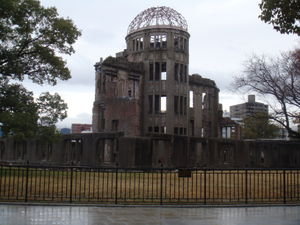Advertisement
Published: January 12th 2008

 A-Bomb Dome
A-Bomb Dome
Tragically, this is the icon of Hiroshima: a symbol of senseless death and pain.(Actual paraphrasing from an A-Bombing victim's story in the Peace Memorial Museum)
Hiroshima is a relatively small Japanese city known primarily for one thing: being the site of the first atomic bomb ever used in warfare. I left Kyoto very early today under heavy rain, and arrived in Hiroshima around 9:30 in the morning. The Shinkansen (bullet trains) are amazingly fast. I decided to ditch my one-night hostel reservation due it being too far away from the main train station (as I only have about 1.5 days here in Hiroshima, leaving tomorrow evening, I didn't want to go through the hassle of dragging my bag and finding this place). I instead got a room at a minshuku (a budget ryokan, the rooms are traditional Japanese but smaller, without private bathrooms and there is generally no meal service) that is a 5-8 minute walk from the main train station.
After taking care of the lodging/luggage situation, I headed to the Peace Park, home to Hiroshima's biggest draws. The primary sight of Hiroshima is the rather grim A-Bomb Dome, a building that was almost directly below

 Children's Memorial
Children's Memorial
Dedicated to children who died from the A-Bomb, it was inspired by the death of the girl Sadako (you may remember her if you read the book A Thousand Paper Cranes). The colorful cases around her are filled with paper cranes, some formed into elaborate pictures.the epicentre of the bomb and thus did not have its structure knocked to pieces and flattened like almost every other building was. The Dome is left in its current state as a reminder of 1945's horrible mistake. Several other memorials in the park include the Children's Monument, primarily inspired by Sadako, a young girl who died in 1955 of Leukemia from the blast. Anyone who read A Thousand Paper Cranes in school will remember the story of her trying to fold 1000 paper cranes to have her wish of life granted. Tons of paper cranes surround the memorial; I wish I knew origami so I could have added my own. The Peace Memorial Museum costs only a token 50 yen (about 45 cents) and contains information about the nuclear attacks on Japan (including rather gruesome descriptions such as above) and makes a plea for total nuclear disarmament. One of the exhibits displaying this cry is a series of hundreds of telegrams: the mayor of Hiroshima has sent a telegram protesting every nuclear test in the world since 1968.
Having covered Hiroshima's sad past, I finished the afternoon with two more pleasant attractions: Hiroshima Castle and Shukkein Garden, far

 Cranes for Sadako
Cranes for Sadako
Some industrious souls took many paper cranes to form more complex statements, as seen here.less depressing than the previous things. I miss downtown Kyoto, which was a fun way to spend an evening, but at least I found an internet cafe here (not too hard in Japan). Tomorrow I am headed to Miyojima Island, an island near Hiroshima famous for its temple with a floating torii (the Japanese gates in front of shrines), which was built in a place that is covered with water during high tide. I am leaving Hiroshima for Narita in the early evening for my flight from Narita Airport to Bangkok on the 14th, a 7 hour flight to Southeast Asia. As a result, I will most likely not have any updates for the next two days. Fear not if this blog goes temporarily silent.
Advertisement
Tot: 0.077s; Tpl: 0.01s; cc: 13; qc: 27; dbt: 0.0363s; 1; m:domysql w:travelblog (10.17.0.13); sld: 1;
; mem: 1.1mb

 A-Bomb Dome
A-Bomb Dome
 Children's Memorial
Children's Memorial
 Cranes for Sadako
Cranes for Sadako




